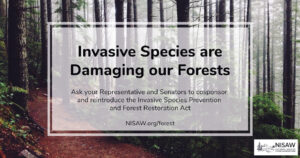By Erika Segerson-Mueller, DNR Invasive Plant Program Specialist, Oshkosh Service Center;
erika.segersonmueller@wisconsin.gov or 715-492-0391

One focus for policy development during NISAW 2024 is forest health and invasive plants. NAISMA has created an easy way to contact your elected officials to let them know you support the Invasive Species Prevention and Forest Restoration Act. / Image Credit: NAISMA.org
While February in Wisconsin may bring to mind snow-covered ground and little new plant growth, it’s quite a big month for action in the invasive species world. The last week of February brings National Invasive Species Awareness Week (NISAW), an international event that focuses on legislation, policies and funding for the prevention and management of invasive species.
Invasive species are non-native plants, animals and pathogens that cause harm to the economy, the environment or human health. Once invasive species are introduced and established outside their normal habitat range, they can cause considerable damage and disturbance to the areas in which they are present.
This year, one of the areas of focus for policy at NISAW is Forest Health and Invasive Species. The Invasive Species Prevention and Forest Restoration Act is a bill from the 118th Congress that seeks to create consistent priorities and adequate resources for containing or eradicating invasive pests in forests. Although governments are working to improve responses to invasive species introductions, the resources available are not always enough to meet current challenges.
The North American Invasive Species Management Association (NAISMA) has created a simple online form that concerned citizens can fill out to send an email to their elected officials, providing their input on the effort to prevent America’s forests from invasive species.
As representatives from state and federal governments and regional organizations gather in Washington, D.C., there are ways to follow along for those interested in invasive species at every level. From Feb. 26 to March 3, NAISMA will host a daily educational webinar that is free to watch. Webinar topics range from the language used to discuss invasive species to protecting North American biodiversity from invasive species threats.
Members of the public can register for the webinars and get the links to attend on the NISAW event page.
Another big event is just around the corner, as Invasive Species Action Month will be observed in June in Wisconsin. Some things interested members of the public can consider in the meantime:
- Learn more about invasive plants and animals in your area by reading the DNR’s invasive species fact sheets.
- Join your local Cooperative Invasive Species Management Area (CISMA). CISMAs are great local resources for invasive plant information, expertise, and action.
- Follow best practices to avoid spreading invasive species into the areas where you work or recreate. Always check clothing, shoes, pets and equipment for plant or animal material before and after spending time in a natural area.
